
Several ancient water wheels still turn along the cobbled Rue des Teinturiers, or the "street of the tinters."
Roman marvels
remain in Avignon
With many ancient and medieval sights
to see, this 2,000-year-old city is also
a good home base for touring
the Provençal region
Home to nine popes during the 14th century and one of the most beautiful cities in France today, Avignon is a treasure house of palaces, museums and meandering lanes, surrounded by a fortified wall.
This city in the heart of beautiful Provence lays claim to dozens of historic monuments, especially the great Palace of the Popes, which grew into an imposing fortification during the 60-year papal residency and is now a museum.
The popes left the Vatican in Rome for political reasons and lived in Avignon from 1316 until 1377, the city's Golden Era, when great mansions and the massive wall were built. Great wealth flowed into the church coffers, some from rowdy foreigners who could pay their way into the city, much like today's tourists, such that wise visitors make plans to visit in the off-season.

The main sights
Orient yourself with the town's two main squares, the Place de l'Horloge and the adjacent Place du Palais containing the Palace of the Popes. This UNESCO World Heritage Site is considered the largest Gothic palace in all of Europe, although its original furniture is gone and its cavernous rooms are mostly empty.After visiting the palace, exit the palace back door, through the wine bar and gift shop, into the old neighborhood where ancient Romans established their town 2,000 years ago, following the Greeks and prehistoric tribes. Simple Roman ruins are still visible on the right side of the small square.
The pedestrian shopping district extends 10 square blocks south, but save it for tomorrow. Energetic types might opt for a 10-block circular stroll through quiet back alleys and over to busy Rue Carnot, then walk back toward the palace on Rue de la Croix. Return to the Place du Palais along an ancient lane adjacent to the palace, Rue Peyrollerie, dramatically carved into the bedrock.
On the northern end of Palace Square, you will spot the fortresslike Petit Palais, built in 1318 as a mansion with Gothic pointed arches and an interior courtyard. Now a museum, it houses a collection of 300 medieval paintings, including Botticelli's "Madonna and Child." The main thrill is simply walking through this delightful mansion, home to Julius II before he became pope. You might also stop inside the nearby Cathédral Notre Dame des Doms, the town's major surviving Romanesque structure.
Walk a few minutes north from the Place du Palais into a lovely public park called Roche des Domes, resting on the top of a small hill overlooking the Old Town. From the ramparts, take in the beautiful views across the city's rooftops and across the Rhône River. You will also spot the romantic castle of St. Andre in the distance and the famous half-bridge, Pont St-Bénezet, your next destination.

From the ramparts of the public park called Roche des Domes, you can see across the city's rooftops and across the Rhône River. You will also spot the romantic castle of St. Andre in the distance.
Don't bother paying admission to walk on the bridge unless you want to dance on it as in the famous 15th-century children's song: "On the bridge of Avignon, everyone is dancing." You'll be able to see it well from the river bank. This was the only bridge across the lower Rhône River when built, connecting the kingdoms of France and Germany, and thereby turning Avignon into an important trading center.
The Old Town: Enter the Porte du Rhône gate through the town wall, then turn right at Rue Grande Fusterie, dotted with picturesque 15th-century houses. At the end, turn right, then left to Place Crillon, site of Hotel d'Europe, where you might consider staying. This is four-star deluxe but has some moderately priced rooms, especially in the off-season. Avignon makes an excellent home base for visiting the Provençal region, with many fine hotels in all price ranges.
Stroll one block over to Rue Joseph Vernet, perhaps the prettiest street in town, lined with shops, galleries and restaurants. Detour a few blocks up and down Rue St. Agricol, which offers a similar environment of pleasant shops and leads to the main square of town, Place de l'Horloge.

Pont du Gard is the tallest ancient bridge and the second-highest structure the Romans ever built, after Rome's Colosseum. It is part of an 2,000-year-old, 26-mile water channel. Coming all the way to Pont du Gard, you don't want to settle for views from the visitor center. Stroll across the bridge, then up a hillside path to gain access to the aqueduct's upper level, where you can walk through the canal itself.
At the information office, pick up a free "Welcome to Avignon" brochure listing major sites and containing a useful map. The tourist bureau placed colored arrows on the sidewalks coordinated with the map to help keep you on track. Also available at the office are train and bus schedules, along with information about packaged day-trips.
Continue strolling along Rue de la République, the town center's busiest street, extending from the train station nearly to the Pope's Palace in a straight mile-long line. There are restaurants and fast-food choices along this broad artery, but wait until you get back to the main square, Place de l'Horloge, before deciding where to dine.
Place de l'Horloge: This popular square has many cafes all around it and a mix of restaurants that range in quality from simple bistro to fine dining. Several lovely streets branch out from this main square, but by now it is probably time to pick an appealing spot for dinner and save further walking for tomorrow. Of course, there are other dining places in town a bit less tourist-oriented than those in this main square, but locals eat here, too, and the advantage of dining in Place de l'Horloge at a choice outdoor table is the delightful ambience -- lots of people walking by, beautiful buildings all around and a lovely, tree-shaded park environment throughout the square.

The streets around Avignon's main square, Place de l'Horloge, make for a pleasant afternoon stroll. The square has many cafes around it from simple bistro to fine dining.

Walking tours
Avignon's Old Town is a charming neighborhood of shopping lanes, narrow residential streets and little back alleys. Some of these routes are for pedestrians only, especially in the shopping center just southeast of Place de l'Horloge. At a half-mile wide and long, this historic center can easily be seen on foot in one day. The curved streets will keep you guessing what's around the bend or which museum or monument is coming up next. Streets are level, riddled with little plazas, fountains, trees, benches and numerous cafes. While the façades are historic, shops and galleries feature modern interiors and contemporary European items for sale.Start with a cup of coffee in the main square, Place de l'Horloge, enjoying the Town Hall's neoclassical façade and colorful swirl of the Carousel, with dozens of people ambling by. Walk to the south end of the square and turn east into the pedestrian-only neighborhood for exploring. At first this shopping zone will seem vast and disorienting, but this is a good orientation for serious browsing later in the day.
Find your way to Rue des Marchands and then past the Synagogue to Place Pie, a large, tree-lined square surrounded by quaint buildings and cafes. Pass through the indoor food market, Les Halles, emerging on the south end at Rue Bonneterie, which turns into the picturesque Rue des Teinturiers, the "street of the tinters." Several ancient water wheels along this cobbled lane are still turning, pushed along by a quaint little tree-lined canal. The wheels once provided power for textile manufacturing and dyeing. Now this is a trendy street, with cafes, boutiques and a small theater, a mere 10-minute walk from the town center. Return at twilight, when the street takes on a different atmosphere.
Stroll back on the Rue des Lices, feeling free to wander left or right as the spirit strikes. A few blocks north are two important churches worth visiting: St. Didier, one of the largest Gothic churches in Provence, and the mid-14th-century St. Pierre. This will take you back to the main Place de l'Horloge and put you in prime position for lunch, followed by shopping or a couple of museum visits.

The crocodile fountain in the square at Place du Marché symbolizes the Egyptian victories of ancient Roman soldiers who retired in the area.
Paintings from the 19th and 20th centuries are on display at another excellent, small museum, Le Musée Angladon, with masterpieces by Degas, Manet, Sisley, Van Gogh, Cézanne, Picasso and Modigliani, among others. This former private Angladon family mansion also exhibits furnishings, drawings and several period rooms upstairs, including an artist's studio, a Chinese room and a Renaissance room. It is located just behind the archaeology museum at 5 Rue Laboureur.
These main museums should be enough for most visitors and could keep you busy most of the afternoon, leading right into the cocktail hour. Another dozen smaller museums, archives, libraries and historic homes are open to the public, so one could actually spend another full day in pursuit of culture.
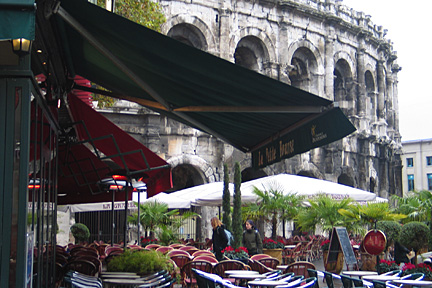
Nimes' star attraction and the world's best-preserved ancient Roman amphitheater, Les Arenes, is similar in age and appearance to Rome's Colosseum but only half the size, seating 24,000 people.

Nimes and Pont Du Gard
Avignon is ideally situated to offer a variety of day trips. Some of the best choices include St-Rémy-de-Provence, Les Baux-de-Provence and Aix-en-Provence. These picturesque towns were described in an earlier (May 1) article about Arles, which can also be reached from Avignon or used as a home base from which to see this region, depending on your preferences.Two worthwhile experiences are a visit to the ancient Roman aqueduct, Pont du Gard, and a side trip to the small city of Nimes, with its Roman sights and a pretty town center.
Head straight to the train station and leave Avignon for Nimes before breakfast. An early start is needed because the last convenient bus returns to Avignon by 2 p.m. Trains leave Avignon at 6:38 and 7:26 a.m., taking 40 minutes to put you into the heart of Nimes before the shops have opened, when the town is quiet and peaceful. Nimes makes a nice two- or three-hour diversion and leaves you in good position to catch the bus to Pont du Gard.
Exit the Nimes train station and walk a few blocks along Avenue Feucheres to a shady park, and just beyond to the town's star attraction and the world's best-preserved ancient Roman amphitheater, Les Arenes. The arena is similar in age and appearance to Rome's Colosseum but only half the size, seating 24,000 people. It is still home to a variety of entertainment, including concerts and the French version of bullfighting, in which bulls are not killed while chasing would-be matadors out of the ring.
A lovely pedestrian zone of shops and cafes extends beyond the right side of the arena, with the main lane of Rue de l'Aspic running 10 blocks through its center. Most shops open at 10 a.m. Check them out on your way back to the station later; for now stroll six blocks on Rue de l'Aspic and turn left on Rue General Perrier to Maison Carrée or the "square house," France's best-preserved Roman temple.
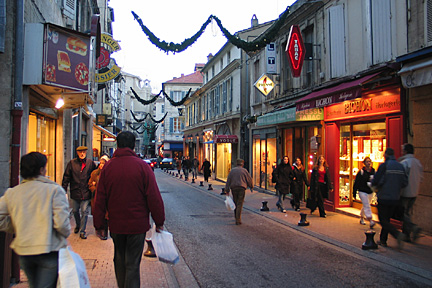
Rue St. Agricol offers an environment of pleasant shops and leads to the main square of town, Place de l'Horloge.
Across the street from Maison Carrée, you will notice a striking modern building designed by British architect Sir Norman Foster. Crafted in steel and glass in a pleasing rectangular shape, it complements the ancient temple architecture and houses the Museum of Contemporary Art, one of several major modern structures built in Nimes during the 1990s by its progressive mayor, Jean Bousquet.
Walk along scenic Quai de la Fontaine next to a beautiful, tree-lined canal that comes from the Jardin de la Fontaine a few blocks away. This pleasant section of town was where the local water source sprang from the ground in Roman times, but as the settlement grew, the water supply became inadequate and needed to be supplemented by a major aqueduct system, including the Pont du Gard.
By now you will have likely worked up an appetite that could be satisfied at the breakfast buffet in one of Nimes' nicest hotels, the four-star Imperator Concorde near the Jardin de la Fontaine. Afterward, walk back to Maison Carrée, then continue east a few blocks along the pedestrian Rue de l'Horloge toward more landmarks: the scenic Place Aux Herbs square, setting for the 11th-century Cathedral Notre-Dame with its Romanesque frieze across the façade, and two blocks northeast, the Porte d'Augustus, a small triumphal arch built in 15 B.C., honoring Emperor Augustus.
History buffs might take time for the Musée Archéologique, two blocks south of the arch, but others might choose to return to the heart of the pedestrian zone via Rue de l'Aspic. En route, have a look at the pretty square, Place du Marché, with its crocodile fountain symbolizing Egyptian victories of ancient Roman soldiers who retired in the area. Buses depart from the open lot behind the train station to take you to Pont du Gard.
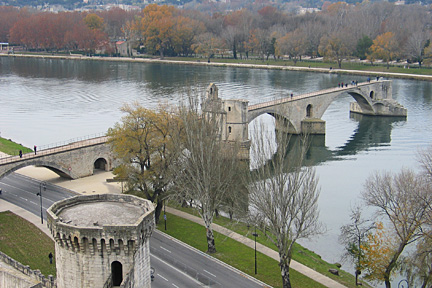
Pont St-Bénezet, Avignon's legendary bridge, was built in the late 12th century as the only bridge across the lower Rhône River, connecting the kingdoms of France and Germany, and thereby turning Avignon into an important trading center.
Pont du Gard is part of an ancient, 26-mile water channel built mostly on or under the ground to carry water to Nimes. The Romans built this bridge about 2,000 years ago to maintain an even flow of water, with just a slight change in level, dropping only about an inch every 300 feet. This engineering feat is a UNESCO World Heritage Site.
Three levels of arches hold up the water channel that runs across the top. The tallest arches Roman engineers ever built are on the bottom.
Their buildings relied heavily on the arch, for many interior spaces were variations of this critical feature: large rooms were often made with barrel-vaulted ceilings, a series of arches connected together, and an arch could also be spun around on its axis to form a dome, another important Roman innovation.
Coming all this way to Pont du Gard, you want to enjoy the various vistas for a complete appreciation. The paved path from the visitor center affords some decent views, but don't settle for this. Stroll across the bridge, then up a well-marked hillside path to gain access to the aqueduct's upper level, where you can walk through the canal itself. It is partly open and partly covered, forming a dark tunnel that tall folks will need to stoop to get through. Here you acquire firsthand respect for the amazing engineering skill that created this marvel.
Exiting the aqueduct channel, walk back downslope, then along the stream on the sunny side of the structure a few hundred yards to get the best view looking back. On calm days you'll get a mirror reflection of the bridge in the river's smooth surface.
Keep one eye on the clock, for you need to catch the bus to Avignon, leaving the same traffic circle at 1:22 p.m. and arriving in Avignon at 2 p.m. If you miss it, you'll have to wait for another bus at 6:45 p.m., reasonable only if you spent more time in Nimes earlier in the day. Otherwise, it will be nice to be back in Avignon by midafternoon to catch up on sights you might have missed, do more shopping or take a nap to recover from these three intensive days.
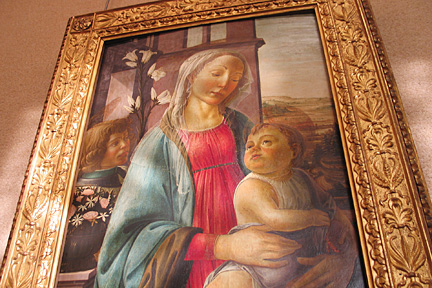
The Petit Palais was built in 1318 as a mansion with Gothic pointed arches. Now a museum, it houses a collection of 300 medieval paintings, including Botticelli's "Madonna and Child."
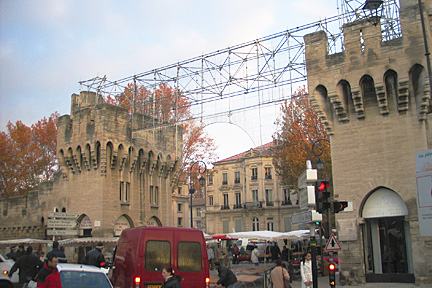
The Porte de la République is the busiest gateway through the ancient wall into the old town of Avignon and leads to the main street, Rue de la République. A flea market is held there.
www.angladon.com
www.avignon.fr
www.avignon-et-provence.com
www.palais-des-papes.com
E-mail to Travel Desk
[News] [Business] [Features] [Sports] [Editorial] [Do It Electric!]
[Classified Ads] [Search] [Subscribe] [Info] [Letter to Editor]
[Feedback]
